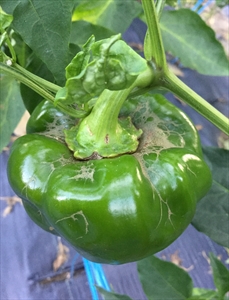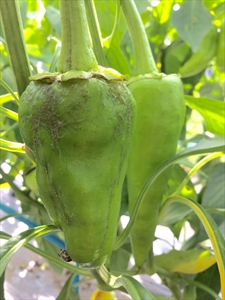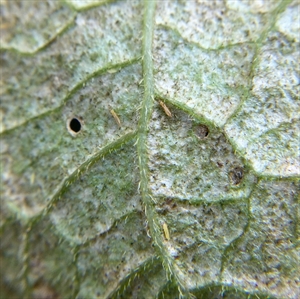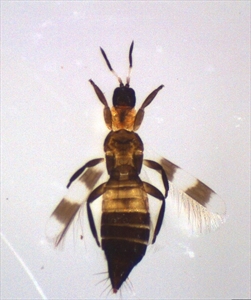Thrips are named after the plants that they live on, e.g., bean thrips, chilli thrips, western flower thrips, melon thrips, onion thrips, tobacco thrips. Some species are predators.
Pacific Pests, Pathogens, Weeds & Pesticides - Online edition
Pacific Pests, Pathogens, Weeds & Pesticides
Thrips - general (086)
A number of thrips species (e.g., Thrips and Gynaikothrips species) have been identified as pests of vegetables, flowers and trees in Pacific island countries. There are many endemic species (Australia, Fiji, French Polynesia, New Caledonia, Papua New Guinea), and also those that are introdused.
Thrips of different species occur in every country. Those that are common and of economic significance in Oceania are the onion thrips, Thrips tabaci (see Fact Sheet no. 117), and the melon thrips, Thrips palmi (see Fact Sheet no. 106). The western flower thrips, Frankliniella occidentalis, (see Fact Sheet no. 183) has not been recorded in Pacific island countries, but is a threat as it is present in Australia and New Zealand.
Tomato, capsicum, melon (see Fact Sheet no. 106), onion (see Fact Sheet no. 117), and many other crops. Predatory thrips prey on plant-eating thrips and spider mites.
Thrips feed by puncturing plant cells and sucking the sap. Cells collapse, forming pits, distortions and brown patches on the leaves (Photo 1); later, the leaves have a silver sheen, or a 'scaring' occurs on the fruits (Photos 2-5). Heavy infestations cause leaves to wilt, dry and die (Photo 4). Black faecal spots are a characterist signs of their presence.
Adult thrips are narrow, less than 2 mm long, yellow to black depending on the species, with wings that have long hairs at the margins (Photos 7-9). The wings cover the body when they are not in use. Thrips are difficult to see without a hand lens. The eggs are bean-shaped, white, laid on or inside the plant. The lifecycle has six stages: egg, first and second larva (small, whitish and very active, found mainly on the underside of the leaf), pre-pupa, pupa (both stages occur in the soil in natural cracks), and adult. The pre-pupa and pupa are similar in shape to the larvae, but do not move, feed, and show the developing wings.
Thrips occur all year round, but are particularly active in hot, dry times following heavy rains.
Thrips damage plants in two ways: first, they pierce the cells of the plants they feed on and suck out the juices; and second, they spread viruses. Feeding begins when the leaves are still inside the buds, or fruits are still inside the flowers, and damage is only seen when they expand. It may not be possible to find the thrips on damaged leaves because they have already moved to feed elsewhere. Damaged fruits may not be suitable for market. Leaves may dry out and die early. In Pacific island countries, it is not known if thrips spread viruses.
Elsewhere, thrips (Thrips and Frankliniella species) spread a group of viruses called 'tospoviruses' which cause important diseases in tomato (Tomato spotted wilt virus), capsicum, tomato, beans, lettuce and eggplant, flowers, and weeds. The tospoviruses group contains some of the world's most damaging viruses. They are the only insect that spreads these viruses.
Look on the underside of the leaves and inside flowers. The larvae are very difficult to see with the naked eye, but with a hand lens the long slender, black bodies of the adults are easily recognised. Look for black or brown specks where the thrips feed; these are faeces. The presence of faeces is a way of telling thrips from mites.
NATURAL ENEMIES
Several natural enemies feed on thrips. There are predatory thrips, minute pirate bugs (Photos 10&11), predatory mites, lacewing larvae and ladybird beetles (adults and larvae). Note, it is best to avoid pesticides to manage thrips, especially those pesticides that are long lasting, as they will destroy populations of beneficial insects.
CULTURAL CONTROL
Before planting:
- Rotate crops with non-host plants to break the lifecycle. Crops commonly attacked by thrips include: beans, cucurbits, crucifers, tomato, and capsicum.
During growth:
- Intercrop with a non-host plant helps to slow the movement of thrips through the crop. For example, grow peppers between yard long beans.
- Destroy weeds within and around crops to prevent build-up of thrips populations.
- Use a hose with a strong jet of water to remove thrips from the plants.
- Maintain plant health with appropriate nutrition and irrigation.
After harvest:
- Destroy crop remains after harvest to prevent thrips spreading from old to young crops.
CHEMICAL CONTROL
It is unlikely that thrips populations will be high enough to justify use of pesticide. In any case, the use of pesticides is likely to do more harm than good, as they will kill natural enemies. Also, thrips tend to hide in sheltered places on plants - in leaf and flower buds or under the 'calyx' (see Photo 2) of the fruit - and they are also difficult to reach with pesticides. If pesticides are applied, try plant-derived products (botanical sprays) first, and always try to treat the undersides of the leaves. Do the following:
- Use plant-derived pesticides, such as derris, chilli (see Fact Sheet No. 504), garlic, neem (see Fact Sheet No. 402), onion, papaya, and pyrethrum (see Fact Sheet no. 56). The toxicity of these PDPs is lost within a few days in sunlight.
- Alternatively, and possibly a better choice, is to use horticultural oil (made from petroleum), white oil (made from vegetable oils), or soap solution (see Fact Sheet no. 56).
- White oil:
- 3 tablespoons (1/3 cup) cooking oil in 4 litres water
- ½ teaspoon pure hand soap, not detergent
- Shake well and use.
- Soap:
-
Use soap (pure soap, not detergent):
- 5 tablespoons of soap in 4 litres water.
-
- White oil:
- Commercial horticultural oil can also be used. White oil, soap and horticultural oil sprays work by blocking the breathing holes of insects causing suffocation and death. Spray the undersides of leaves; the oils must contact the insects. A second application of soap or oils may be necessary after 3-4 weeks.
- Use entomopathogenic fungi such as Beauveria bassiana or the nematodes Heterorhabditis and Steinenema species.
- Use microbial insecticides, such as abamectin or spinosad, derived from microoganisms. Alternate with other products to prevent the build-up of resistant thrips populations.
- Do not use broad-spectrum insecticides such as dimethoate (under review in Australia, and not allowed for use in home gardens), malathion or synthetic pyrethroids. They can have a greater effect on the natural enemies of thrips than on the thrips themselves.
--------------------
Note, derris (Derris species) contains rotenone, an insecticide, often used as a fish poison; it should be used with caution. The commercial derris insecticide is made from Derris elliptica.
____________________
When using a pesticide (or biopesticide), always wear protective clothing and follow the instructions on the product label, such as dosage, timing of application, and pre-harvest interval. Recommendations will vary with the crop and system of cultivation. Expert advice on the most appropriate pesticide to use should always be sought from local agricultural authorities.
AUTHORS Suzanne Neave & Grahame Jackson
Information from Trips (2021) Wikipedia. (https://en.wikipedia.org/wiki/Thrips)' and J. Bethke JA (2014) Thrips. How to manage pests in gardens and landscapes. UC/IPM. (http://ipm.ucanr.edu/PMG/PESTNOTES/pn7429.html); and Which thrips is that? A guide to the key species transmitting Tomato spotted wilt virus in NSW. Complied by Marilyn Steiner. NSW Department of Primary Industries. (https://www.dpi.nsw.gov.au/__data/assets/pdf_file/0006/177324/tswv-transmitting-thrips.pdf); and from ThripsWiki - providing information on the World's thrips. (https://www.thrips.info/wiki/Main_Page & https://www.thrips.info/wiki/Australasian_Region_(and_Pacific). Photos 4-7 Mani Mua, SPC, Sigatoka Research Station, Fiji. Photo 10 Diane Alston, Utah State University, Bugwood.org. Photo 11 Wikipedia. (http://en.wikipedia.org/wiki/Orius). It is not known if this insect is in Pacific island countries; it is given as an example of this type of bug.
Produced with support from the Australian Centre for International Agricultural Research under project PC/2010/090: Strengthening integrated crop management research in the Pacific Islands in support of sustainable intensification of high-value crop production, implemented by the University of Queensland and the Secretariat of the Pacific Community.














